-
Car Reviews
- All reviews
- Midsize SUVs
- Small cars
- Utes
- Small SUVs
- Large SUVs
- Large cars
- Sports SUVs
- Sports cars
- Vans
Latest reviews
- Car News
-
Car Comparisons
Latest comparisons
- Chasing Deals
After 56 years and 12 generations, Toyota’s Corolla small car lineage spawns an SUV version. And it looks to have its ducks lined up for mass-market success
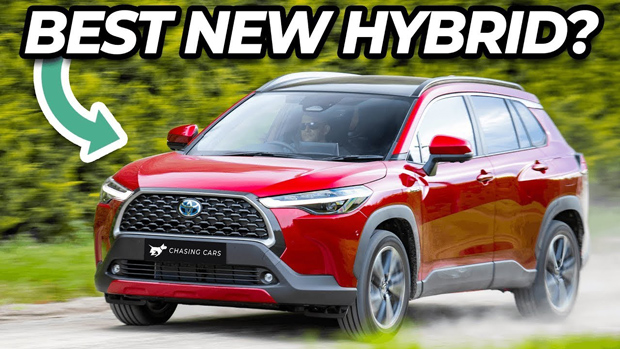
Two things immediately strike when you first see the new Toyota Corolla Cross in the metal. Firstly, it’s not really the Corolla we know and many love at all. And, secondly, its existence makes convincing sense, even if now the Big T has two small SUVs in its ever-burgeoning family-hauler lineup.
It doesn’t look like its Corolla sedan or hatch stablemates. At all. And while, yes, the new Corolla Cross shares its TNGA-C platform and some core elements – parts binned interior features, say – with the ‘regular’ Corolla, even its wheelbase, some 60mm shorter than the sedan, is different.
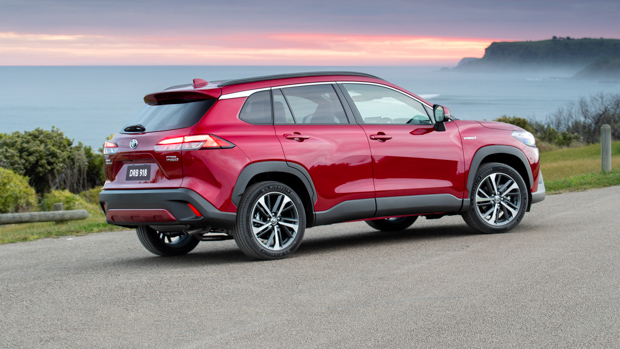
Let’s face it. The Corolla namesake is applied primarily because it’s trustworthy, familiar, warm and fuzzy. Any technical commonality is, realistically, coincidental.
Toyota’s latest addition to its burgeoning SUV/crossover/wagon stable finds itself nestled between the compact Yaris Cross and outrageously popular midsize RAV4 as its new small-sized SUV…alongside the existing small C-HR. But why two different models?
For its various virtues, the C-HR has sat as Toyota’s style-driven, quasi-sporty crossover, big on spunk but, frankly, not all that accomplished at genuine family-friendliness. The Corolla Cross, by contrast, is a much more sensible and practical small-stature spin, even sized, clearly, as a missing link between Corolla and RAV4 as a sort of, erm, ‘smedium’ offering.
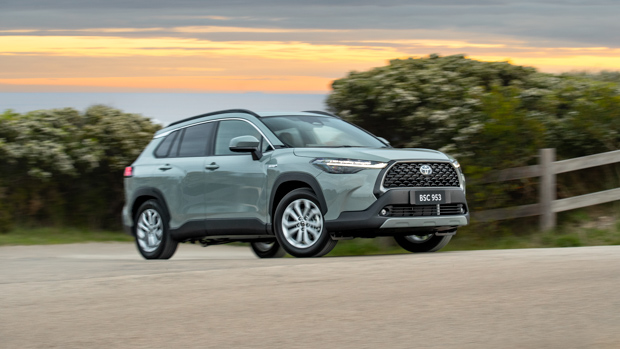
In concept, it makes a whole of sense: the fun-to-drive element of the utility-compromised Corolla and a commodiously practical, slightly smaller alternative to the RAV4 that, at last glance, still languishes with long wait times for ownership delivery. The Corolla Cross only really needs to tick off family-friendliness essentials to, by any reasonable reckoning, become hugely popular.
You only need to look at pricing to see that Toyota Australia has utmost confidence in a warm Aussie reception to Corolla Cross. The range tips in at $33,000 list for the entry front-driven petrol GX and top out at – gulp – $49,050 list for the all-you-can-eat Atmos AWD Hybrid, or a mid-fifties proposition driveaway.
Sat between the GX and the (unusually named) Atmos sits the familiar GXL mid spec.
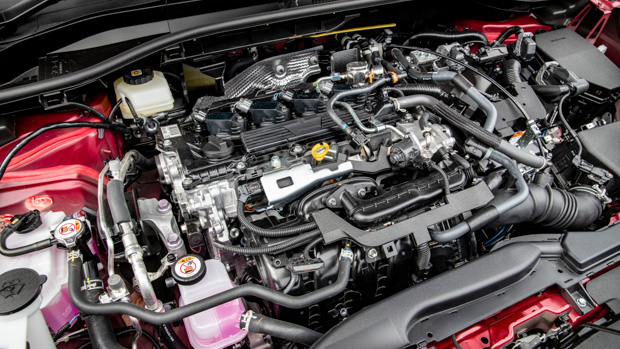
The 124kW/202Nm 2.0-litre petrol FWD configuration can be had throughout the range. The same goes for the hybrid FWD guise, at a 147kW peak by combining 112kW/190Nm Atkinson cycle combustion with 83kW/206Nm electric assistance, for a $2500 premium.
Hybrid-only all-wheel drive is offered on the GXL and Atmos only, adding a 30kW rear-axle motor, commanding a further $3000 upcharge over the petrol-electric front-driver.
The Corolla Cross debuts Toyota’s so-called “fifth-generation” hybrid technology with a raft of changes to the motor-generators, lighter lithium-ion battery packs, electronics changes and general enhancements promising, primarily it’s claimed, improved drivability as much as anything.
Still, there’s no turbocharging and, it seems, no revolutionary leap in powertrain tech. Read between the lines, good old natural aspiration does inherently bring dependability and lends itself to low servicing costs: two oh-so important pillars in Toyota’s brand pitch.
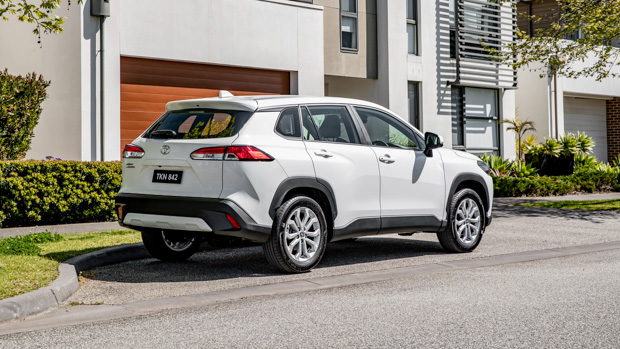
The Corolla Cross also debuts Toyota’s “next-generation” multimedia format, slick and new, that gushes techy delights, from “Hey Toyota” voice control to over-the-air sat-nav updates to the sort of phone app control where you can remotely start the engine and activate the climate control. Or monitor other drivers – your kids – via telemetry, Big Brother style.
Safety, too, gets the grand treatment: automatic collision notification to emergency services, enhanced AEB with intersection and motorcycle detection, new emergency steering assist functionality, misacceleration protocols, deceleration assist within the lane changing tech…the list goes on. Its importer claims that no other Toyota model to date has packed as much active safety and connectivity goodness as its new small SUV.
We sampled numerous variants at the Corolla Cross’s local launch, if focussing on the ultimate Atmos AWD Hybrid version for core assessment.
The holistic Corolla Cross experience on road is largely familiar and mostly surprise free. And that should please a good many of its target buyers most of the time.
If this is a whole new generation of self-charging hybrid drive, it tough to discern it by the seat of the pants. Is it more response to the driver’s input? Maybe. Does it offer better drivability? Perhaps. Be it FWD or AWD – we sampled both and they’re very similar to one another – there’s perhaps a little more polish in all-round execution, if you’re splitting hairs and really taking notice.
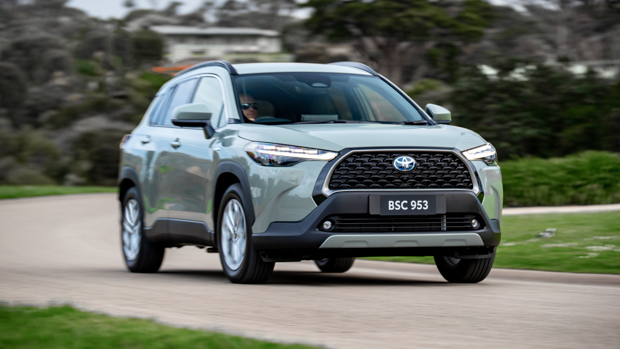
As is tradition, drive is clean and silent in electric mode that the Corolla Cross, as hybrid Toyotas do, tends to favour around town. As the good many owners of the format are no doubt familiar with, it doesn’t take much throttle input for the Atkinson cycle petrol four to bark into life, its rumble nicely muted if ever-present in the eardrums.
It’s polite enough and ambles about at a casual clip two up and without much luggage aboard. Refinement, too, is decent enough provided you don’t treat the right pedal with too much enthusiasm. Driven sedately, this powertrain can be downright pleasant.
But dig in and the petrol four sounds gruff when faced with solid acceleration or a decent ascent in the landscape, electric torque assistance failing to mask the engine’s stress, and the rpm-pinning soundtrack strangely out of kilter with progress.
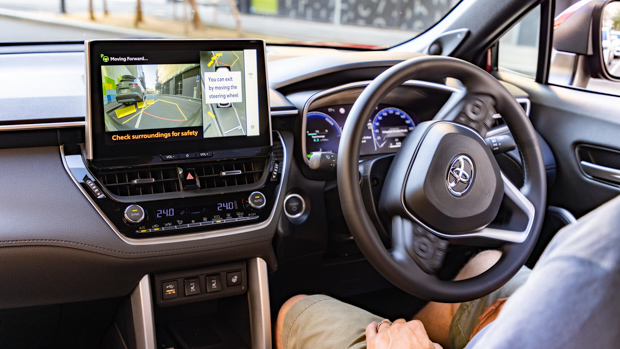
From a stuffy critical viewpoint, Toyota’s hybrid design could be lustier, cleaner and fitter. And turbocharged to augment low-end torque delivery. But as the favoured powertrain in some of the most popular passenger cars in Oz, if it ain’t broken…
Fuel economy claims are quite handy: 4.3L/100km combined for the hybrid front driver, 4.4 for the AWD version. And that a solid improvement over the still-handy 6.0L for the petrol FWD. The hybrids’ thriftiness improves further around town, with its urban claims at 4.1 and 4.3 respectively for the electrified FWD and AWD systems.
The chassis is a real highlight. And that it steers, rides and corners like a regular Corolla – that is, with genuine depth and quality – is also surprise free, even if it’s still quite delightful in the experience.
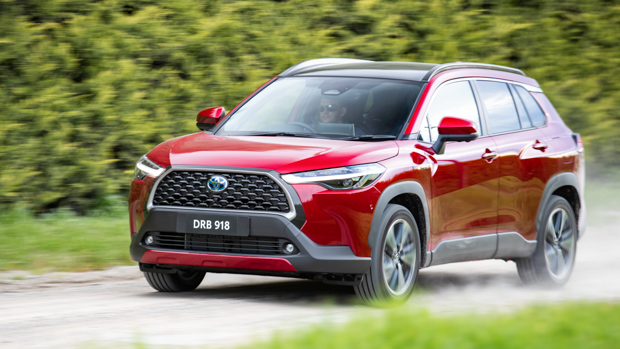
The Corolla Cross seems impressively light on its feet, though that’s relative to the sense of the size of the thing. It really does feel, in some areas, much larger than a Corolla hatch, particularly given the amount of metal forward of the A pillar and height of the roof. And yet it clocks in at just 1380kg kerb in its lightest (base petrol) guise and even the heaviest, full-fruit Atmos AWD hybrid is a still fairly lithe 1550kg.
It points confidently, offers solid engagement at its helm, and there’s some decent – perhaps bonus – dynamic talent bubbling under the surface if you fancy having a scratch.
The damping, too, is well judged and on the move the chassis is both compliant and controlled. If there’s a chink the the ride and handling armour, it’s that the suspension can jolt and thud abruptly across some of road craters that have cropped up from recent and incessant east coast rain. They’re hits that the low-profile 50-series 18-inch wheels of the Atmos only seem to amplify.
Unsurprisingly, the GX and GXL, with their more demure-looking 17s shod with 60-series rubber, rounds out the rough stuff more deftly. And with no apparent detriment to driving engagement.
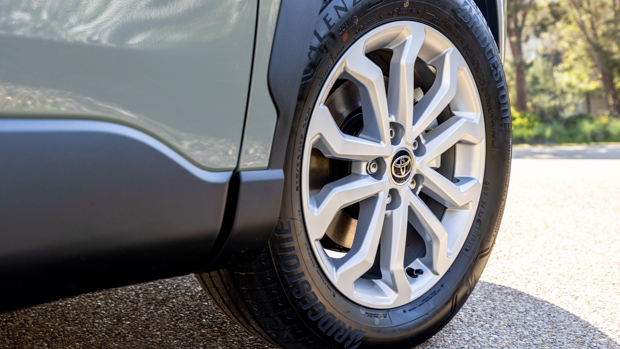
The Toyota Safety Sense suite packs features to the hilt and, on road, there’s ample transparency in the functionality at play. So no strange feedback or random false positives we could detect. It’s worth noting that only the hybrids get some features such as parking brake support with pedestrian detection, the panoramic view monitor – that works quite well – and the Advance Park Assist of smart autonomous parking in high-end examples.
For its sprightly Corolla undertow, the Corolla Cross still feels like an SUV at the helm. You sit higher with the clearer view across the bonnet and yet the vastly higher roofline and generous glass area brings excellent outward visibility. At once, Toyota’s new not-quite-so-small offering – 185mm taller and 45mm wider than Corolla sedan – feels SUV-like substantial, yet very easy to judge, park or place on the road.
This newcomer really is a nice size in the driving experience. But it still needs to pull the right packaging tricks with the passenger space and boot to prove its worth as a genuine, family friendly SUV.
The Corolla Cross interior theme, even in the top-spec Atmos, is quite conventional and traditional. It stands to reason, given that Toyota’s other small SUV, the C-HR, occupies the role of bringing funky, crossover freshness to this corner of the motoring landscape.
The newcomer is quite conventional, more so than either Corolla or C-HR. Its general design approach and choice of switches, dials and buttons is almost old school in areas. And the theme of our test car, with its middling grey-out splashed with touches of piano black and chrome highlights, is thoroughly unadventurous.
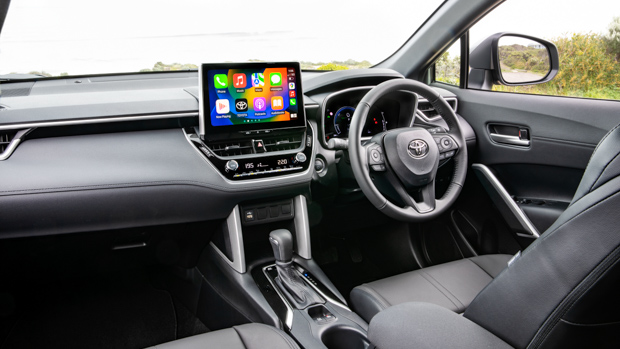
But what it lacks in forward-thinking swagger it makes up for in simple, easy-to-use clarity that’ll undoubtedly appeal to traditionalist tastes.
There’s some compensation in big-screen fanciness: a large 10.5-inch multimedia touchscreen, tacked loud and proud onto the dash fascia, for GXL and Atmos, plus huge fully digital 12.3-inch driver’s instrumentation exclusively for the flagship model.
This is Toyota’s new whizbang infotainment format, an atonement for multimedia sins of past systems that have barely keeped in step with wider motoring progress. And, well, it’s fine…
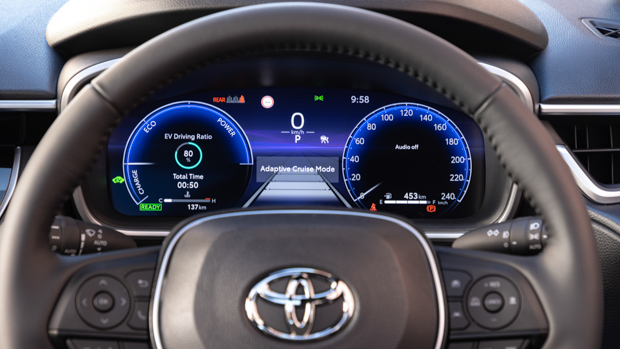
The homescreen’s shortcut strip and List and Info panels make navigating features easier than the clumsy formats of old and the screen is sharp and bright. It’s now deeper, richer and slicker in content and simpler in user interface. The sat-nav is cloud-based with real-time updates for weather, traffic and whatnot – it works well enough, though it’s a solid if not a remarkably slick or cutting edge affair.
Ditto the driver’s screen. It’s large, bright, brings fancy animation chops and adds some much needed colour to the cabin theme. But some of the content and choice of skin designs won’t cause some mainstream rivals – let alone premium tech torchbearers – to lose much sleep.
Still, it’s a pleasant space in which to spend long-haul seat time. The generous glasshouse and panoramic roof, with its raised ceiling, brings a bright and airy ambience in both rows of seating.
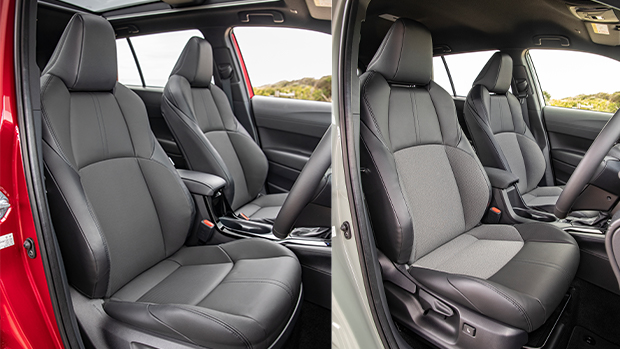
Left: Corolla Cross Atmos, right: Corolla Cross GX
The front seats are supportive and comfy, are leather accented and offer eight-way power driver adjustment. They’re heated though, strangely, not cooled (because: Australia) though the dual-zone climate control system fitted is a decent system.
You get a trio of USB-C ports, an inductive phone charging pad and…nothing really much that edifies the Atmos Hybrid AWD’s mid-$50k driveaway outlay, bar perhaps the impressive grand glass roof. The excessive use of quite ordinary trim plastics is one anchor for Corolla Cross’s hopeful upmarket ascension.
Row two space is excellent: it really feels roomy by all measures and offers the kind of space you’d hope for in a larger midsize offering. For ambience, spaciousness and outward visibility, it’s both child and adult friendly. The enormous headroom paids real dividends. Vents, aforementioned dual USB-C ports, dual cup holders in the armrest. All expected if little that’s otherwise remarkable.
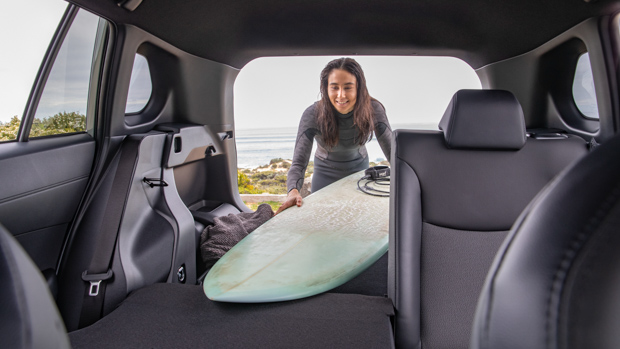
Quite un-Corolla-like is the SUV’s boot space. Where the regular hatchback offers 217 litres (or up to 333L in ZR hybrid, sans spare wheel), the Corolla Cross brings between 380L and 436L depending on the variant. Toyota quotes that dropping the second row liberates as much as 1359L of load space.
In as-tested Atmos Hybrid AWD, you get the small luggage capacity and an inflator kit, as fitted to all-paw versions. Front drivers get a space saver spare.
As mentioned above, the Hybrid versions of Corolla Cross promise 4.3L (FWD) and 4.4L (AWD) combined consumption. And the claims become marginally more favourable with urban usage. Petrol front driven versions are quoted at 6.0L combined.
Both powertrain types run on 91RON fuel.
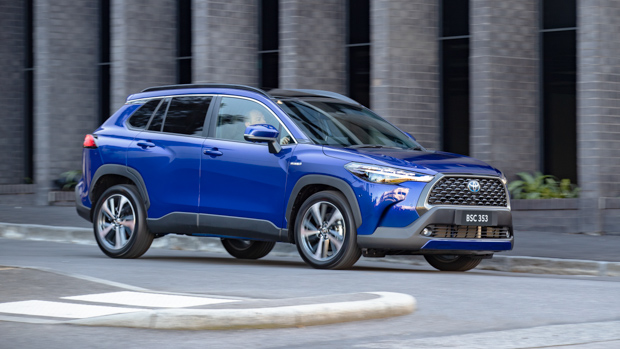
Capped-price servicing is $230 per visit on 12-month/15,000km terms for the first five years of ownership. By a small margin, it’s dearer to service than the Corolla hatch, which costs $205 per visit.
Warranty is a typical five years of unlimited-kilometre surety.
Buried deep in the press material supplied at the local Corolla Cross launch sits an ominous line from the horse’s mouth. And one that could read too much into it or draw a long bow off the back of it.
“…With the launch of the new Corolla Cross – adding an SUV to the lineup – the Corolla nameplate is set to continue for many years to come,” reads the press release.
Still, we’re assured by Toyota that the regular Corolla hatch and sedan, and indeed C-HR, are set to continue as mainstays of its lineup despite the arrival of Corolla Cross. And yet, in this increasingly homogenised motoring landscape drifting ominously towards ‘total SUV-dom,’ is this SUV version what Corolla is destined to morph into later, or perhaps sooner?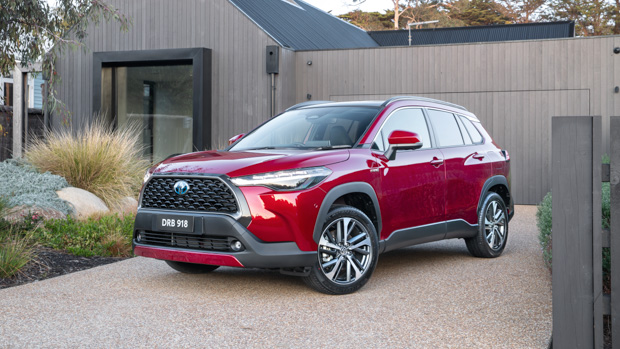
Whatever the case, the somewhat expected and quite unsurprising Corolla Cross is perhaps precisely what it should and needs to be. Its lack of spirit of adventure be damned.
And precisely because of it, Toyota’s new small SUV really does hit the mark. It’s exactly what you might want if C-HR is too funky, Corolla is too small (and un-SUV-like) and you can’t stomach the wait for mister popularity in RAV4. And yet you really want those friendly and familiar oh-what-feeling traits of the newcomer’s stablemates in what’s a convincing amalgamation.
The sweet spot in range? We’ll need to shake out more variants, though we suspect the GXL Hybrid FWD, smack bang in the middle of the lineup, brings the best of petrol-electric convenience, features, spaciousness and, at a touch under $40k list, price.
Key specs (as tested)
About Chasing cars
Chasing Cars reviews are 100% independent.
Because we are powered by Budget Direct Insurance, we don’t receive advertising or sales revenue from car manufacturers.
We’re truly independent – giving you Australia’s best car reviews.
The estimate provided does not take into account your personal circumstances but is intended to give a general indication of the cost of insurance, in order to obtain a complete quote, please visit www.budgetdirect.com.au. Estimate includes 15%^ online discount.
^Conditions Apply
Budget Direct Insurance arranged by Auto & General Services Pty Ltd ACN 003 617 909(AGS) AFSL 241 411, for and on behalf of the insurer, Auto & General Insurance Company Limited(ABN 42 111 586 353, AFSL 285 571).Because we don’t know your financial needs, we can’t advise you if this insurance will suit you. You should consider your needs and the Product Disclosure Statement before making a decision to buy insurance. Terms and conditions apply.
Indicative quote based on assumptions including postcode , 40 year old male with no offences, licence suspensions or claims in the last 5 years, a NCD Rating 1 and no younger drivers listed. White car, driven up to 10,000kms a year, unfinanced, with no modifications, factory options and/or non-standard accessories, private use only and garaged at night.
^Online Discounts Terms & Conditions
1. Discounts apply to the premium paid for a new Budget Direct Gold Comprehensive Car Insurance, Third Party Property Only or Third Party Property, Fire & Theft Insurance policy initiated online on or after 29 March 2017. Discounts do not apply to optional Roadside Assistance.
2. Discounts do not apply to any renewal offer of insurance.
3. Discounts only apply to the insurance portion of the premium. Discounts are applied before government charges, taxes, levies and fees, including instalment processing fees (as applicable). The full extent of discounts may therefore be impacted.
4. We reserve the right to change the offer without notice.